Snam life

About Snam Employees
People are central to Snam’s activities, and Snam values them by offering them opportunities for professional growth in an inclusive and meritocratic environment. With the opening up to new businesses for the energy transition, the need to expand know-how and skills in these fields has been accompanied, in recent years, by a significant increase in human resources, which in 2020 amounted to 3,249 (+7.4% compared to 2019). In this respect, a total of 376 entries were recorded during the year, 145 more than in 2019. Of these, 226 are due to market hires and 150 to the consolidation of Mieci, Evolve, Snam4Efficiency, TEP Nord Est, the consolidation of a resource in Snam and returns to service from leave. The 152 exits were lower than the previous year (222 in 2019) and were mainly due to termination of employment due to reaching retirement requirements (143, of which 47 unilateral terminations), 7 for other reasons and 2 for transfers to non-consolidated companies.
A comparison of the data on the number of voluntary entries and exits, the voluntary exit rate (only 1.5%), as well as the length of service of about 17 years, highlight not only the growth of the Group, but also how Snam has created an environment where employees see opportunities for development and the chance to realise their skills, growing together with Snam. The Group offers a stable and continuous employment relationship (93.4% of employees have a permanent contract) and hires highly qualified and specialised resources (54% of employees have a technical diploma and 29% have a university degree). At the end of 2020, there were 42 part-time employment contracts and 197 apprenticeship contracts, while during the year, 43 workers were employed under temporary contracts (32 in 2019).
Snam is a company that is gradually becoming younger: with an average age of 44.5, people under 40 (1,274) represent 39.2% of the company population, an increase of 110 units compared to 2019, thanks also to the hiring of young resources in recent years, able to bring new knowledge and skills with respect to new businesses for the energy transition. The value of experience is provided by people over 50, who make up 44.2% of the company population. The absenteeism rate, which in 2020 amounted to 5.9%, is basically in line with that of previous years and only increased slightly due to the fact that, under the trade union agreement, those who could not use smart working were granted a period of paid leave of 6 days or more.
Employees at December 31, 2020
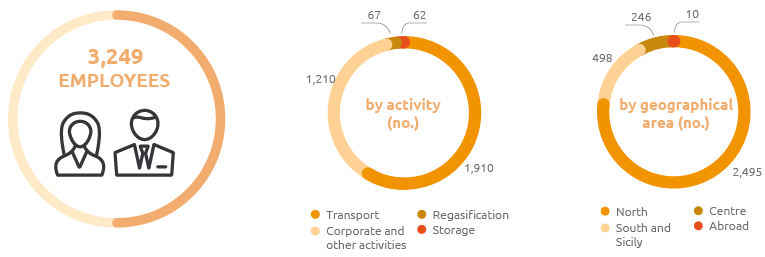
Employees by age group (no.)
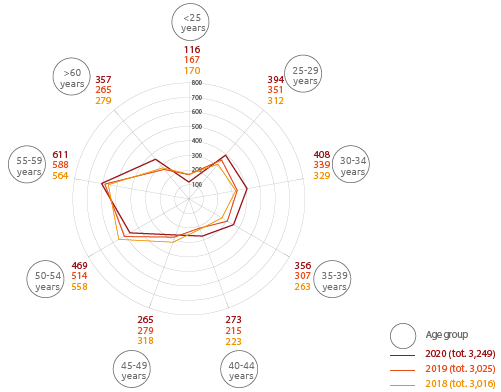
| Download XLS (11 kB) |
|
2018 |
2019 |
2020 |
||
|---|---|---|---|---|---|
Working class |
|
|
|
||
Executives |
107 |
111 |
131 |
||
Middle Managers |
480 |
493 |
549 |
||
White collars |
1,682 |
1,683 |
1,764 |
||
Blue collars |
747 |
738 |
805 |
||
Education |
|
|
|
||
University graduates |
777 |
819 |
949 |
||
Secondary school graduates |
1,703 |
1,714 |
1,759 |
||
Other qualifications |
536 |
492 |
541 |
||
Type of contract |
|
|
|
||
Permanent (*) |
2,812 |
2,817 |
3,036 |
||
Apprenticeship – placement |
185 |
193 |
197 |
||
Fixed-term |
19 |
15 |
16 |
||
Part-time |
41 |
38 |
42 |
||
|
|||||
Staff turnover* (%)
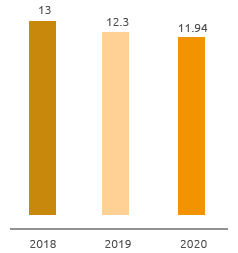
*Turnover rate = ((entries from the market + exits) / average workforce in service) x100.
Exits due to transfers to non-consolidated companies are excluded.
Turnover rate (%)

(*) Voluntary turnover rate = (exits due to resignation/average workforce) x 100.
Exits due to transfers to non-consolidated
companies are excluded
(**) Exit rate = (exits/ total employees at 31/12) x 100.
Absenteeism rate* (%)
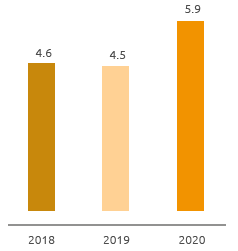
* Absenteeism rate = (hours of absence/workable hours) x 100
The absenteeism rate indicated does not include management and has been calculated by taking into account all hours not worked (paid and unpaid), excluding holidays, recoveries and periods of abstention from work for compulsory and optional maternity.
Hires from the market and exits by age group (no.)
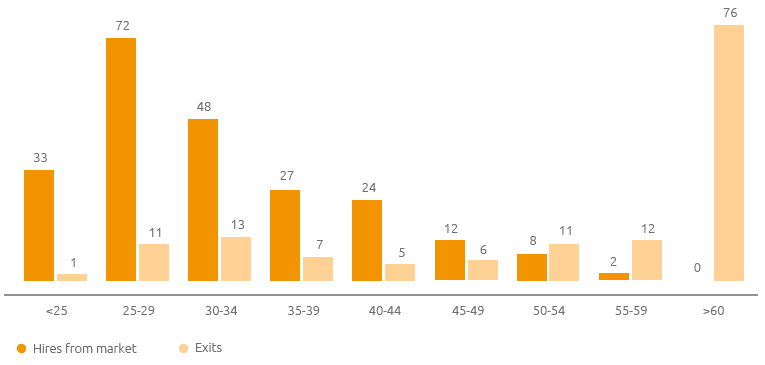
Remaining close even if distant
Snam considers communication with employees to be a fundamental lever for promoting the participation of its people and for encouraging the sharing of values and principles, but also of projects and initiatives. The strategic importance of internal communication also lies in its ability to create and disseminate value through transparent communications, increasing the sense of belonging. Internal communication activities have focused on a wide range of topics, including solidarity, inclusion, diversity and sustainability, made possible also through the increasingly strong collaboration with Snam Institute and Fondazione Snam. During the year, emphasis was also on the impact of the health emergency, in relation to which numerous initiatives were created to convey the Group’s closeness to employees, to offer psychological support and to keep Snam people constantly updated on the Company’s strategies and activities in such a complicated context.
The success of the projects and initiatives implemented is reflected in the employee engagement index, a performance indicator that has been included in the Group’s ESG Scorecard. In 2020 alone, this target has already been widely exceeded, with an engagement of 82%, which has also grown thanks to the progressive integration of the subsidiaries, both from the communication point of view and from that of the activities implemented, with a view increasingly oriented towards One Company. Other initiatives that closely involved employees in 2020 included the release of the revamped Easy corporate Intranet, which, since 2019, has been the subject of an agile re-design project, concluded in July 2020 with the organisation of a virtual launch event with the CEO, followed by 5 remote info-training sessions open to all colleagues. In a One Company perspective, the on-boarding of Cubogas colleagues on Easy was completed in October and work was prepared for the subsequent integration of Renerwaste people. With the aim of feeling close even if distant, the CEO met virtually with employees through a webinar, also on the occasion of the presentation of the new 2020-2024 Strategic Plan, which was followed by a Q&A session for the entire organisation.
Snam has also been communicating for years through the magazine “Energie” and the newsletters “Osservatorio Gas” and “InRete”, which are full of content, news and contributions from its employees concerning the company and the gas market. In 2020, in particular, the magazine “Energie” increased its pagination and, in line with the Paperless Project, was distributed only in digital mode, and the Newsletter “Osservatorio Gas” added a new in-depth section with news, analyses and comments on the gas market 360 degrees. Finally, in the context of the Paperless Project and the progressive digitalisation of communication, Snam has continued its digital signage activities, i.e. the installation of internal screens in its offices, integrating social feeds and distributing QR codes for reading news on the Intranet from mobile devices.
2020 Engagement activity
Snam paperless
In 2020, the Project Paperless was launched, a communication campaign to encourage the reduction of paper waste, through interventions of digitalisation of processes and dematerialisation of activities, thanks to which a 30% reduction on 50% of total consumption is expected. In addition, in 2020, Snam quantified a reduction of 50% on printing and distribution of distribution of internal mail, documents which now are now digitally signed and sent by e-mail, avoiding printing of paper forms. The Paperless project involves employees in all levels of the company, which are encouraged to reduce the use of paper in their activities.
Snam plasticless
In 2020, the Plasticless Project continued, aimed at eliminating all single-use plastic at dispensers and beverage dispensers at all company locations, replacing biodegradable and compostable materials. The project is part of awareness-raising activities towards employees, which, thanks their actions, will contribute to the achievement of the objective set by the Company.
Valuing and including diversity
The Diversity & Inclusion Team, with a view to valuing and including diversity, has started a collaboration to create the Inclusion Team in bottom-up logic and to promote active participation in the initiatives promoted by the team.
Snamwood
Snam has launched the Snamwood project, which involves the planting of a forest of over 3,330 trees dedicated to all the people Snam, in collaboration with Arbolia. An online contest has allowed all colleagues to vote the name of the forest dedicated to them.
Close to employees during the pandemic
The interpersonal distance caused by the pandemic made it necessary for Snam to make numerous efforts to ensure the constant dissemination of information to the entire corporate population, to maintain and strengthen the sense of belonging to the Company and not to leave its people alone, who were forced to rethink the way they worked together, but separately. Right from the start of the emergency, Snam launched a continuous, direct and transparent communication action towards its people, guided by a caring and inclusive approach to the different situations that colleagues in the various corporate areas found themselves experiencing – from continuous smart working, to presence in the territorial offices for the operational areas, with the aim of providing timely information, guaranteeing support and always putting its people at the centre, at a time when the need to make the company’s presence felt close to the individual was stronger than ever. In this context, the #distantimauniti initiative took shape, to promote listening and maintain a high level of corporate engagement, providing psychological support, using the revamped Easy Intranet as a “virtual wall” where Snam people could share thoughts and reflections, strengthening the sense of community, cohesion and belonging to the company, and organising training and awareness-raising webinars on the pandemic.
Health emergency management
Information

- Direct mail updates and news on the Intranet a total of more than 90 emails sent from the interra communication and related news published on Easy, the company portal, to ensure transparency and information, from 21.02 to the end of the year.
- 7 video messages from the CEO for update and information.
- Video message to raise awareness by Dr. Giovanni Albano, Hhumanitas doctor working in the Covid-19 wards.
- Medical and scientific information webinar with Prof. Burioni to promote responsible conduct and containment of risk of contagion.
- Health Protocol that led to the implementation and updating of the document of conduct guidelines, signposting in company offices and video tutorials to disseminate good practices for respect of the provisions of health and safety at work.
Engagement

- Collection of messages #distantimauniti for a total of more than 400 messages collected and published on Easy and on Snam’s social media.
- 3 webinars with CEO #distantimauniti to create opportunities of dialogue and discussion on how the company dealt with the various phases of the emergency.
- Support for the planning and promotion of the fundraising event “Diamo Forma al Futuro”, in collaboration with Fondazione Snam.
- Christmas with Snam, a series of virtual events, live and otherwise, on a dedicated platform, aimed at all colleagues and their families to enjoy together a day of closeness during the festive season.
- Best wishes online, a meeting for year-end celebration, dedicated to all the people in the company, this year held entirely online under #distantimauniti.
Listening, caring and wellbeing

- Survey of listening Covid-19 and follow up, a questionnaire given to the entire company population to monitor the colleagues’ perceptions of company measures and collect useful ideas on possible areas of intervention. The average rate of response rate was 65%.
- Support for design, implementation and promotion of services and initiatives for colleagues and families, from the Covid-19 policy, healthcare services and serological campaigns, from support initiatives for smartworking (smart kit, data SIM and tethering service), to Covid-response welfare packages designed especially for colleagues and their family members.
- Spreading good rules for smartworking in order to work remotely effectively and efficiently.